Lowering high blood pressure can be difficult.
You need to relax more and get adequate sleep.
Take medications daily- as though it’s natural.
Exercise regularly.
And perhaps hardest of all, change the way you eat.
The cruel twist?
You can’t feel stressed by any of this because it only makes things worse (1)…
High blood pressure (known medically as hypertension) is easy to get, and hard to get rid of. And it shows in the data.
One in every three American adults has high blood pressure, and it contributes to 1,000 US deaths per day.
To normalise blood pressure is one of, if not the most important thing you can do to increase your health, quality of life and lifespan.
Fortunately, evidence shows there’s an abundance of natural food to lower blood pressure available to us. Rather than cutting things out, science shows that you can really benefit from adding these into your diet.
So if you’re struggling with blood pressure, these are a must try.
1. Nitrates in beetroot can lower blood pressure
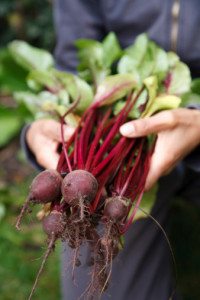
Nitrates and nitrites are compounds that play a big part in our metabolic system.
The influence they have can be quite confusing, but it’s definitely worth understanding if you’ve got blood pressure problems.
Many believe nitrates and nitrites are unnatural, although that’s not actually the case. They are commonly added to foods as preservatives, but they are also naturally produced by your body for saliva (2, 3).
What’s important to know is nitrates and nitrites can be converted into two different compounds: Nitrosamines (very bad) or Nitric Oxide (very good). To put it simply:
Nitrates –> Nitrites –> Nitrosamines OR Nitric Oxide
Nitrosamines are produced when nitrites are exposed to extremely high temperatures. Think frying nitrites in preservative-loaded bacon, or nitrites in cigarettes. Most of these cause cancer (4).
Nitric Oxide (NO) on the other hand acts as a signalling molecule, typically beneficial to health. It gives signals to the cells in your arteries, telling them to soften and relax (5, 6).
This action greatly improves vasodilation which reduces blood pressure (7, 8, 9). Here is a nice illustration of the type of action NO has.
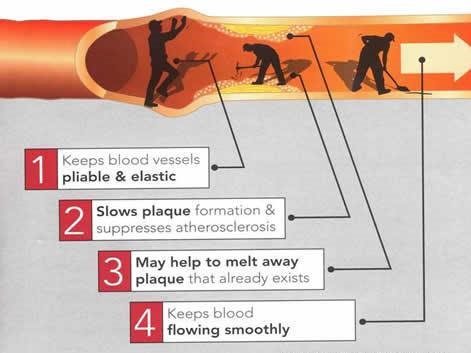
Photo source.
For this reason, nitrate-rich foods that are not exposed to very high heat are beneficial because they can become nitric oxide.
What most don’t realize is that vegetables are the largest source of nitrates in the human diet (7). Beetroot is the best of the bunch, with most research focusing on beetroot juice supplementation.
A 2013 review looked at the results of 16 previous clinical trials on the topic, totaling 254 participants (10).
Researchers found that beetroot juice intake reduces blood pressure by 4-10 mm Hg in just a few hours. A reduction of at least 5 mm Hg in blood pressure reduces your risk of a life-ending stroke by 14% and cardiovascular diseases by 9% (11).
Summary: Beetroot juice contains high levels of nitrate which can be converted into beneficial nitric oxide. Studies show it can reduce blood pressure by between 4-10 mm Hg in a matter of hours. While long-term effects have not yet been examined, it seems highly unlikely beetroot juice would be dangerous.
2. Garlic can reduce blood pressure and LDL cholesterol
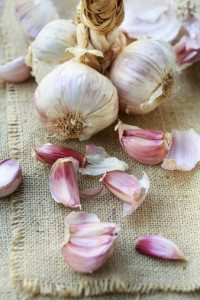
Did you know garlic was not traditionally used for cooking?
Throughout history, garlic’s main use was for health and medicinal reasons. This has been documented by all the major civilizations including the Egyptians, Babylonians, Greeks, Romans and Chinese (12, 13).
The active ingredient in garlic is allicin, a sulphur compound formed when a garlic clove is crushed, chopped or chewed.
Several human studies have shown that supplementing with garlic significantly improves the blood pressure of those with elevated blood pressure. One study even found garlic was just as effective as prescribed medications after 24 weeks (14, 15, 16, 17).
Considering that garlic also reduces LDL cholesterol by 10-15%, adding more to your diet is an absolute necessity in my opinion (15, 18, 19).
Free Download: Lower Your Blood Pressure In 30 Days, Without Medication.
[thrive_2step id=’969′]Click here to download[/thrive_2step]
.
These results have been seen with supplementation of 600-1,200 mg per day, equal to eating at least two garlic cloves daily.
There is one strong side-effect though… bad breath.
Summary: Garlic can help lower blood pressure in those with elevated blood pressure. Long-term supplementation can even be as effective as certain prescription blood pressure medications for some. The active ingredient in garlic, allicin, is believed to provide these health properties.
3. Fish oil can help those with high blood pressure
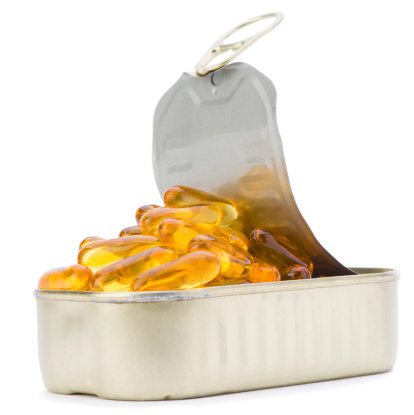
Fish oil refers to the natural fatty acids found in certain fish species.
These fatty acids – such as Omega-3 fats – are extremely beneficial to human cardiovascular health.
Many human trials and reviews have found fish oil supplementation to be an effective treatment for high blood pressure (20, 21, 22, 23, 24).
However benefits are only seen in those with existing high blood pressure (hypertension).
The mechanism of effect is not clear, but most experts believe it is to do with the Omega-6: Omega-3 ratio.
Essentially, the more Omega-3 fats in your diet compared to Omega-6 fats, the better for your heart health. A 1:1 ratio is ideal; linked with much healthier and stronger blood vessels (25).
Our ancestors were thought to have a ratio of between 1:1 and 4:1 (Omega-6: Omega-3). However due to the heavy use of vegetable oils today, the average western diet has a ratio of 16:1 (26, 27).
In other words, for every 16 grams of Omega-6 fats consumed, we only consume 1 gram of Omega-3.
Improving your ratio to 4:1 is associated with a 70% decrease in cardiovascular-related death (28).
The best way to do this is by consuming more Omega-3 fats such as oily fish, olive oil, walnuts and flaxseed. It also helps to limit other seed/vegetable oils which tend to be high in Omega-6 fats.
Fish oil supplements are an effective and more affordable alternative to eating oily fish. However, if accessing sustainable fish is not a barrier for you, then it’s advised to have 2-3 servings per week rather than supplements.
Summary: There is strong evidence that fish oil supplementation improves blood pressure in those with elevated blood pressure. This is likely due to the improved Omega-6: Omega-3 ratio of a diet higher in fish oil. Fresh fish is best, but supplements are a good alternative.
4. Cashews and almonds can dramatically reduce your blood pressure
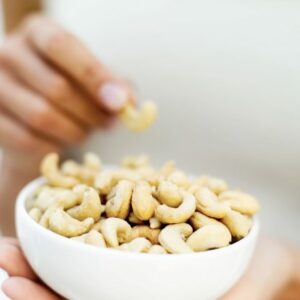
Tree nuts are linked with many metabolic health benefits (not to be confused with peanuts, which grow in the ground).
But almonds and cashews really standout, particularly when it comes to metabolic problems such as high blood pressure.
What makes them so influential is their magnesium content.
Magnesium is an essential mineral involved in over 300 bodily process (29). Cashews and almonds are one of the richest natural sources of magnesium.
A lack of magnesium in the diet (deficiency) is very strongly associated with blood pressure complications. This holds true whether you are overweight or not (30).
As you would expect then, correcting low magnesium has been shown to significantly reduce high blood pressure in numerous studies (31, 32, 33, 34).
Given that approximately 68% of US adults eat below the recommended intake of magnesium, you can see how more almonds or cashews in the diet could make a big difference (37).
Interestingly, one study on type 2 diabetics only saw reductions in blood pressure once vitamin C and E were added to their magnesium supplementation (38). Something for diabetics to keep in mind if you do decide to use supplements rather than whole foods.
The current recommended daily intake for magnesium in the US is 310-420 mg (39). One cup of almonds or cashews provides a whopping 360 mg; what I recommend to clients to help maintain optimum levels.
Magnesium supplements are a good alternative, but getting your nutrients from whole foods should typically be your preferred source.
Summary: Cashews and almonds are very high in magnesium, with one cup providing your daily requirements. Having low magnesium levels is very strongly linked to high blood pressure. Many studies have shown replacing this magnesium deficiency will significantly improve blood pressure.
5. Kale may significantly lower blood pressure

Kale is one of the few “superfoods” that is actually a superfood.
Similar to spinach, it is loaded with vitamins, minerals, antioxidants, and other compounds known to help prevent disease.
But the reason kale may reduce high blood pressure is because of its incredibly unique nutrient profile. It’s rich in magnesium, potassium and vitamin C (40).
A diet high in potassium is strongly linked to lower blood pressure (41). This could be because magnesium’s effect on blood pressure is enhanced when combined with more potassium. In some cases this combination can lower blood pressure as much as medications (42).
Unfortunately we no longer eat much potassium.
Our hunter-gatherer ancestors consumed around 10,500 mg of potassium per day, whereas the average American today has roughly 2,800 mg per day (43).
But the reason I give preference to kale over spinach is because it has four times more vitamin C too.
Similar to the potassium-magnesium relationship, vitamin C appears to increase the blood pressure lowering effects of magnesium as well as increase potassium in the blood (38, 44).
Kale’s nutrient trio of magnesium, potassium and vitamin C makes it unrivaled for blood pressure control and minimising disease risk.
If you could only pick one leafy green vegetable, it has be kale.
Summary: Kale has an incredibly unique nutrition profile that is rich in magnesium, potassium and vitamin C. The research suggests that both potassium and vitamin C enhance the blood pressure-lowering properties of magnesium.
6. Stevia may be a food to lower blood pressure over the long-term
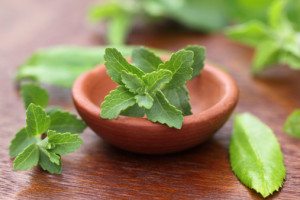
With refined sugar now recognised as harmful, sweetener alternatives have become incredibly common; Stevia being one of the more popular choices.
It’s is one of the few natural sweeteners and doesn’t appear to be harmful like many of the artificial sweeteners on the market.
The two active ingredients that make Stevia sweet are called Stevioside and Rebaudioside A.
A one year trial on participants with high blood pressure found those given 750 mg stevioside per day decreased their blood pressure by 8.1% (systolic) and 13.8% (diastolic) after 3 months. They were able to maintain this reduction for the next nine months (45).
Another study using high doses of stevioside (1,500 mg per day) noted that after 2 years blood pressure decreased by around 6.5% (46).
There were a couple of studies that failed to find any health benefits, however these were very short-term and used healthy participants (47, 48). Sweetener users are typically in it for the long-run.
If you are looking to replace sugar, or already using another type of sweetener, stevia appears the best choice for those with blood pressure problems.
It’s by no means a quick fix, but the long-term effects seem to be safe and maybe even beneficial.
Summary: Long-term use of stevia has been shown to decrease blood pressure in those with existing high blood pressure. It is not likely to be beneficial in small doses, but certainly not harmful.
7. Curcumin in turmeric may help improve blood flow
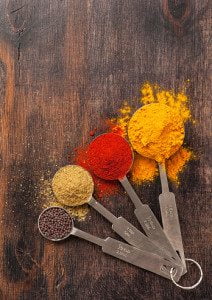
Turmeric is a popular Indian curry spice.
For centuries Indians used it not only in their cooking but also as a medicinal herb. And they were onto something.
Turmeric’s medicinal properties have only recently been confirmed by science and are very impressive (49).
The main active ingredient in turmeric is curcumin, which has powerful anti-inflammatory effects in the body.
In a study of 32 post-menopausal women, supplementing 150 mg of curcumin for 8 weeks successfully improved blood flow to levels seen in those who exercise three times per week (50).
Another human study using 500 mg turmeric three times per day (22.1 mg curcumin each time) reported large decreases in blood pressure in subjects with nephritis (51). Those with cardiovascular issues, particular diabetics, are at high risk for kidney problems like nephritis.
The benefits curcumin has on blood flow and blood pressure are believed to be related to nitric oxide, similar to beetroot mentioned above.
Supplementation of curcumin has shown to increase circulating nitric oxide, in some cases by up to 40% in just four weeks (52, 53).
These potential cardiovascular benefits are too great to ignore, especially if you are at high risk of complications. But there is just one problem with curcumin…
Humans are very bad at absorbing it.
For any noticeable health benefits, it is essential to consume curcumin with an enhancer such as Black Pepper. Black pepper contains piperine, a substance which boosts curcumin absorption by a whopping 2,000% (54).
So be sure to add plenty of pepper to your turmeric-based curry. Or if you decide to supplement, eat some whole peppercorns at the same time (hat-tip to Kris of Authority Nutrition).
Summary: Turmeric is very rich in curcumin, shown to improve blood flow and decrease blood pressure in those with existing kidney problems. The benefits are thought to be related to nitric oxide, similar to beetroot juice.
8. Green tea can greatly improve blood flow
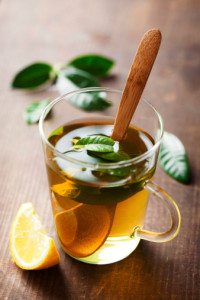
Traditionally from China, green tea is loaded with many powerful compounds and antioxidants; a combination that is unrivalled by any other food (55).
The reason tea – in particular green tea – is so beneficial is because of its polyphenols.
One particular green tea polyphenol, known as catechins, have shown to improve blood flow and pressure. Like beetroot and curcumin, the mechanism is thought to involve nitric oxide (56, 57, 58, 59).
A large review of green tea confirmed that two cups per day (500mL) can increase arterial diameter by up to 40% (60). Just like wider pipes will increase water flow, wider and more relaxed blood vessels increase blood flow, reducing pressure.
It’s no real surprise then that regular green tea drinkers have up to a 31% lower risk of cardiovascular disease (61, 62, 63).
Summary: The catechins in green tea have been shown to increase the diameter of arteries by up to 40%. This results in improved blood flow and reduced blood pressure.
9. Green coffee may decrease blood pressure in those with hypertension
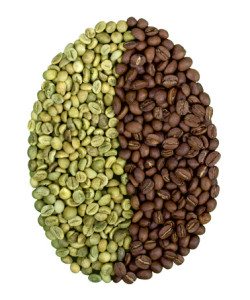
Coffee beans are naturally green in colour, but roasting turns them brown.
So in essence, green coffee is just another name for unroasted coffee.
While roasted coffee beans have a similar chemical composition to green coffee beans, the roasting process destroys much of its Chlorogenic acid (64).
This is the active ingredient that gives green coffee beans additional health properties. It’s also the ingredient extracted for use in supplements such as Green Coffee Bean Extract (65).
While green coffee bean extract may not be the “weight loss miracle” Dr Oz claimed, it does appear to benefit blood flow in one way or another. At least in the short-term (66, 67).
One 12-week study using 480 mg of green coffee extract (equal to 140 mg of chlorogenic acid) found it reduced heart rate and blood pressure by about 8%. These benefits were maintained for 12 weeks of supplementation, but only in those with high blood pressure to start with. What’s more, benefits were lost once supplementation stopped (68).
Theoretically, drinking more green coffee should have much of the same benefits as supplementing, but it depends on the chlorogenic acid concentration. Doses used in these studies were equivalent to 120-300 mg of chlorogenic acid.
For practicality’s sake, try swapping your regular coffee for green coffee and then checking for any blood pressure changes after a month.
Summary: Green coffee contains chlorogenic acid, the active ingredient with most of the health properties. Chlorogenic acid supplementation has been shown to reduce blood pressure after 12 weeks in those with existing hypertension.
10. Vitamin K2 from full fat dairy improves vascular health

For decades we were told to cut all fats from our diets.
Unfortunately, these recommendations were based on bad science and terrible assumptions.
Some national bodies are finally coming around and making changes, innovative Sweden being the first.
In looking at fat intake and blood pressure specifically, full-fat dairy may be beneficial as it contains vitamin K2.
Vitamin K2 helps regulate where calcium ends up in the body. It works to keep calcium in your bones, and remove it from blood vessels where it can cause arterial stiffness and calcification (69, 70).
While no studies exist measuring the direct effect of K2 on blood pressure yet, it makes sense that it would be beneficial given its relationship with vascular health (71, 72, 73, 74).
A soon-to-be published observational study – one of Europe’s biggest – found those who eat eight portions of high-fat dairy per day are 23% less likely to get type 2 diabetes than those eating one portion per day (75). Blood pressure is a key predictor of vascular disease such as heart disease and type 2 diabetes.
Full-fat, grass-fed dairy products are by far the best sources of vitamin K2. This includes butter, cheese, full-fat yoghurt, and ghee. Liver and other organs are good sources too, as are fermented foods such as sauerkraut, natto and miso (76, 77).
If those food sources are not an option for you, supplementation is a valid alternative, and should be taken alongside vitamin D for maximum effect (78).
In my opinion we should all be increasing our vitamin K2 intake as a preventative measure for heart health. Especially if you are particularly vulnerable to artery calcification, such as diabetics or those with a family history of high cholesterol and blood pressure.
Summary: No research has looked at vitamin K2 and blood pressure specifically, but it is strongly linked to vascular health. It helps by removing the dangerous calcium build-up in blood vessels, which in turn helps to optimise blood flow and blood pressure. Full fat dairy is the best source of vitamin K2.
11. Extra virgin olive oil is linked with improved blood pressure
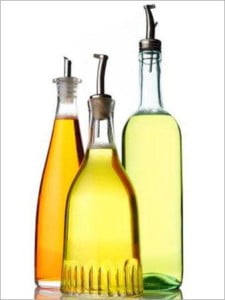
Olive oil is probably the healthiest oil in the world.
It’s a staple of Mediterranean-style diets, and is rich in heart-healthy monounsaturated fats and phenolic antioxidants.
‘Extra-Virgin’ olive oil has the highest levels of beneficial components because it is the least processed form of olive oil.
The cardiovascular benefits of olive oil are certainly no secret, with one major study finding it reduced heart attacks, strokes and death by a whopping 30% (79).
It’s no surprise then that olive oil is a fantastic food to lower blood pressure.
In a study of 23 participants with high blood pressure, extra virgin olive oil reduced blood pressure by 48% compared with sunflower oil. Olive oil intake even cut the need for blood pressure medications in 8 of those participants (80).
Add extra-virgin olive oil to salads, and safely cook with it on almost all occasions.
Summary: Frequent consumption of olive oil has been heavily linked with cardiovascular benefits for many years. Small studies have shown extra virgin olive oil can significantly reduce blood pressure compared to sunflower oil.
Diet is just the beginning…
Of course there are many other factors that influence blood pressure too.
These include physical activity, adequate sleep, sun exposure, meditation and other stress management practices.
In the end, however, the majority of these link back to diet. What goes into your mouth is certainly the most influential factor at play.
There are so many natural foods that may help lower your blood pressure- especially if you’re struggling to manage it without pharmaceutical drugs.
It’s just a matter of trying them out for yourself.
